<Geomagnetic Sensor>
What is a geomagnetic sensor?
Earth’s magnetic field is also known as the geomagnetic field.
Geomagnetic sensors are sensors that detect the magnetic field of the Earth, and are commonly referred to as electronic compasses.
Geomagnetic sensors can determine direction by detecting the geomagnetic field.
Geomagnetic field surrounding the Earth
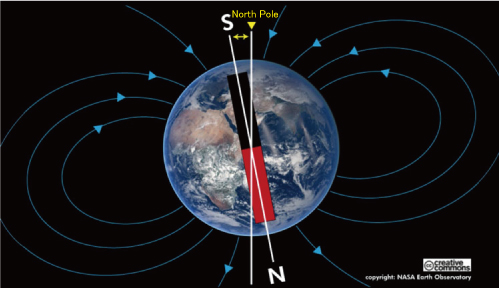
Geomagnetic sensors include 2-axis types (X and Y) and 3-axis models with a Z axis that measures the magnetic force in that direction.
For simple compasses that do not need to consider the slope (inclination), only the X and Y axes are used. However, when tilting the compass it is necessary to correct it in the proper direction by combining the values of the 3 axes from the geomagnetic sensor with an accelerometer.
The below figure shows the distribution chart of the X and Y values when the geomagnetic sensor is rotated horizontally.
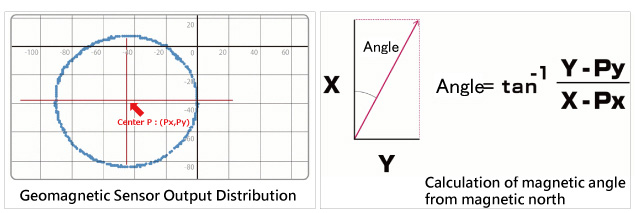
If the geomagnetic sensor is rotated horizontally, in the ideal case where there are no effects from the surrounding magnetic field, the center of the circle of the output distribution map becomes zero.
However, since the center shifts due to the influence of the ambient magnetic field, it is necessary to make an adjustment to move the center of the circle to zero.
The north that can be derived from a geomagnetic sensor is called the magnetic north (which is slightly shifted from the north pole), and the direction can be known by simply calculating the angle from this magnetic north using the above formula.
Various types of magnetic sensors
A magnetic sensor is a sensor capable of measuring the magnitude and direction of a magnetic field.
A variety of sensors exist depending on the purpose, but the following are typical examples.
| Detection Method | Hall | MR | MI |
|---|---|---|---|
| Configuration | 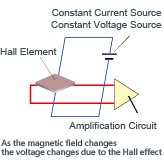 |
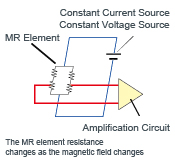 |
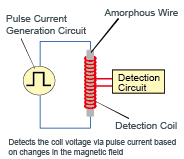 |
| Anti-Noise (Sensitivity) |
× | △ | ◎ |
| Current Consumption | × | △ | ◎ |
| Response Speed | × | △ | ◎ |
Hall Sensor
A sensor that measures the magnetic flux density using the Hall effect and outputs a voltage proportional to the magnetic flux density is called a Hall sensor.
It is easy to use and mainly adopted for contactless switch applications such as open/close detection of doors and notebook PCs.
MR Sensor
An MR (Magnetoresistive) sensor measures field strength through changes in individual electrical resistors based on the magnetic field.
This type of magnetic sensor is used quite frequently due to its higher sensitivity and lower power consumption vs Hall sensors. In addition to geomagnetic detection in e-compasses, MR sensors are used for applications such as motor rotation and position detection.
MI Sensor
An MI (Magneto-Impedance) sensor is a next-generation magnetic sensor that takes advantage of the magneto-impedance effects of a special amorphous wire.
It features more than 10,000 times the sensitivity of Hall sensors, allowing measurement of minute variations in the geomagnetic field with high accuracy.
It is ideal for applications requiring high sensitivity, such as indoor positioning, metal foreign object detection, and ultra-low-current azimuth detection (e-compass).




